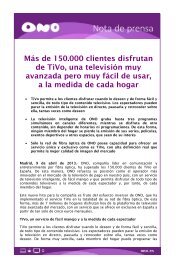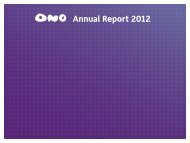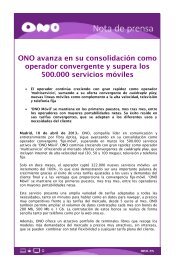Annual report (20-F) - Ono
Annual report (20-F) - Ono
Annual report (20-F) - Ono
You also want an ePaper? Increase the reach of your titles
YUMPU automatically turns print PDFs into web optimized ePapers that Google loves.
equity value certificates by allocating the $1,000 issue price of each dollar unit between the <strong>20</strong>09 dollar<br />
note and the associated dollar equity value certificate and by allocating the €1,000 issue price of each<br />
euro unit between the <strong>20</strong>09 euro note and the associated euro equity value certificate based upon their<br />
relative fair market values.<br />
According to such determination, the issue price of each <strong>20</strong>09 dollar note is $984.59 per $1,000<br />
principal amount, and the issue price of each dollar equity value certificate is $15.41. The issue price of<br />
each <strong>20</strong>09 euro note is €984.59 per €1,000 principal amount, and the issue price of each euro equity value<br />
certificate is €15.41. These allocations establish a U.S. holder’s initial tax bases in the note and the equity<br />
value certificate. These allocations are binding on each U.S. holder, unless such U.S. holder explicitly<br />
discloses (on a statement attached to such U.S. holder’s timely filed U.S. federal income tax return for the<br />
year that includes the acquisition date of the unit) that its allocation of the unit’s issue price between the<br />
note and the equity value certificate is different from the issuer’s allocation. The issuer’s allocation is not<br />
binding on the Internal Revenue Service, or IRS, and therefore there can be no assurance that the IRS will<br />
respect such allocation.<br />
If the “stated redemption price at maturity” of a <strong>20</strong>09 dollar or euro note exceeds its issue price<br />
by more than a de minimis amount (generally defined as ¼ of 1% of a note’s stated redemption price at<br />
maturity multiplied by the number of complete years to its maturity), the note will be treated as having<br />
been issued with original issue discount (“OID”). Based upon the Issuer’s allocation of the issue price of<br />
the units between the <strong>20</strong>09 Notes and the associated equity value certificates, the <strong>20</strong>09 Notes will be<br />
treated as having been issued with no OID under the de minimis rules described above. However, if the<br />
IRS were to disagree with this allocation, it might successfully contend that the <strong>20</strong>09 Notes should be<br />
treated as having been issued with OID, in which case US Holders would be required to include the OID<br />
in taxable income as it accrues over the life of the Notes. See discussion under the caption “Original Issue<br />
Discount” below. US Holders should consult their own tax advisers as to the potential application of the<br />
OID rules to the <strong>20</strong>09 Notes.<br />
Allocation of Purchase Price Between the <strong>20</strong>11 Notes and Associated Equity Value Certificates<br />
The <strong>20</strong>11 Notes were issued in the form of units. Each dollar unit consists of one $1,000<br />
principal amount <strong>20</strong>11 dollar note and one dollar equity value certificate evidencing the right to receive<br />
upon exercise the value of 48.98512580 Ordinary Shares of Cableuropa as of the earliest of certain<br />
defined trigger events. Each euro unit consists of one €1,000 principal amount <strong>20</strong>11 euro note and one<br />
euro equity value certificate evidencing the right to receive upon exercise the value of 45.98831311<br />
Ordinary Shares of Cableuropa as of the earliest of certain defined trigger events. For U.S. federal income<br />
tax purposes, each unit is treated as an investment unit, consisting of a note and an equity value<br />
certificate. The issuer has determined the “issue price” of each of the <strong>20</strong>11 Notes and equity value<br />
certificates by allocating the $1,000 issue price of each dollar unit between the <strong>20</strong>11 dollar note and the<br />
associated dollar equity value certificate and by allocating the €1,000 issue price of each euro unit<br />
between the <strong>20</strong>11 euro note and the associated euro equity value certificate based upon their relative fair<br />
market values. According to such determination, the issue price of each <strong>20</strong>11 dollar note is $862.04 per<br />
$1,000 principal amount, and the issue price of each dollar equity value certificate is $137.96. The issue<br />
price of each <strong>20</strong>11 euro note is €862.03506067 per €1,000 principal amount, and the issue price of each<br />
euro equity value certificate is €137.96493933.<br />
After allocating the issue price of the units between the <strong>20</strong>11 Notes and the associated equity<br />
value certificates in the manner described above, each of the <strong>20</strong>11 Notes will be treated as having been<br />
issued with OID in an amount equal to the excess of (a) the “stated redemption price at maturity” of the<br />
note over (b) its “issue price”. See discussion under the caption “Original Issue Discount” below. U.S.<br />
Holders should consult their own tax advisers as to the potential application of the OID rules to the <strong>20</strong>11<br />
Notes.<br />
Tax Treatment of the Notes<br />
Classification of the Notes. This summary is based upon the assumption that the Notes are<br />
characterized as indebtedness for U.S. federal income tax purposes. Current holders of the Notes should<br />
recognize, however, that there is some uncertainty regarding the appropriate characterization of<br />
instruments such as the Notes, and no rulings have been or will be sought from the IRS with respect to the<br />
appropriate characterization of the Notes for U.S. federal income tax purposes. It is possible that the IRS<br />
might contend that the Notes should be treated as equity in the Issuer rather than indebtedness. Any such<br />
recharacterization might result in material adverse consequences to U.S. Holders of the Notes, including<br />
90
















